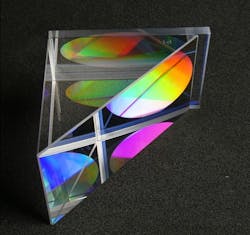Grating and prism combo, ‘GRISM,’ enables high spectral resolutions
Inspired by a need for very high spectral resolutions for spectrographic applications such as remote detection of greenhouse gases, researchers from the Institute of Applied Physics at the University of Jena and the Fraunhofer Institute for Applied Optics and Precision Engineering discovered a way to outmaneuver limitations in wavelength dispersion caused by gratings.
The strongest wavelength dispersion can be achieved by using different diffraction gratings, but dispersion is still limited by the basic physical properties of diffraction. And as you approach the dispersion limit, the nonlinear dependence of the grating’s angular dispersion as a function of wavelength becomes more nonlinear, creating a magnification that changes strongly as the wavelength changes. This isn’t at all desirable for a spectroscopic instrument in which the spectrum per detector pixel must remain as constant as possible.
But this nonlinearity of the spectrum can be overcome by combining a grating with a prism to form a GRISM.
“In our investigation, we discovered the best optical performance can be achieved if the GRISM operates in reflection,” explains Professor Uwe D. Zeitner, head of the Microstructure Technology research group at the Institute of Applied Physics, as well as senior director of Opto-Mechanical Systems for Fraunhofer. “But it’s typically not so trivial to separate the incident beam from the dispersed reflected beam.”
Zeitner and colleagues found a solution in which the light reflected from the grating hits the incidence facet of the GRISM under an angle larger than the angle of total internal reflection (see figure). “This way, the reflected spectrum isn’t directly coupled out from the GRISM in the direction of the incidence beam but directed toward the third face of the GRISM and coupled out there. This allows for a very compact separation of incident and reflected light,” he says.
They also chose the incidence angle onto the grating facet of the GRISM so it’s larger than the angle of total internal reflection. This, combined with a specially designed grating structure, allows them to achieve a particularly high diffraction efficiency for both polarization directions (s- and p-polarization), which is an advantage in spectroscopic applications.
The main takeaway of their work is the combination of different principles of the optical beam path inside the GRISM, the grating profile, and the technological feasibility of the combination of a grating with a prism. “It allows us to simultaneously achieve a dispersion close to the physical limits, the easy separation of incident and reflected beam for a very compact arrangement, the very high polarization independent diffraction efficiency close to 100%, and the linearity of the dispersion across the spectrum,” says Zeitner.
Perhaps the biggest surprise of this work was “finding a solution that fulfills all of the aforementioned aspects, which are typically contradictory,” he adds.
Next up, the researchers want to use this novel component’s advantageous properties in a real-world spectroscopic instrument.
About the Author
Sally Cole Johnson
Editor in Chief
Sally Cole Johnson, Laser Focus World’s editor in chief, is a science and technology journalist who specializes in physics and semiconductors.

